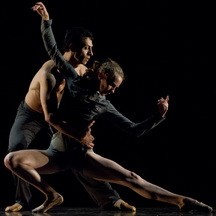Demi, demi, grande plié, relevé…
Behind a lavish scrim of Oriental patterns lies an exotic world figured and reconfigured in over a century’s worth of imaginings by some of ballet’s most legendary dancers and choreographers.
Palm trees and waterfalls, sacred fires, airborne scarves of evanescent lightness and rhinestone-bedecked costumes are only the outward manifestations of the great Bolshoi Ballet’s production of La Bayadère that was performed at Zellerbach Hall this past weekend as part of Cal Performances. The true jewels in the company’s crown are its dancers.
Opening night saw Svetlana Zacharova as Nikiya, the bayadère, or temple dancer, and Nikolai Tsiskaridze as her lover, Solor. Maria Alexandrova danced Gamzatti, the rajah’s daughter, the third side of the story’s ill-fated love triangle.
Zacharova is a dancer of exquisite strength and precision. Rail thin, she is long limbed with a slight hyperextension at the elbows and knees, which gives her arm movements an angular and excessive grace and her extensions the curvaceous line that is the ultimate in ballet desirability. At the end of her breathtaking legs are high-arched feet, both durable and strong. But the features, like the surrounding sets and costumes, are only the highly decorative trappings to what is her core strength as a dancer—her back. Look at her spine: mobile, expressive; and move your gaze to the line that her neck forms from the mid–shoulder blades to the base of the head. The line is straight, completely vertical, with her chin and jaw line tipped slightly down. The force of the muscles of her body and back are pulling upward constantly, as if they would detach from gravity.
A similar quality can be seen in Nikolai Tsiskaridze’s body, at the front of his leg: if you follow the line from the top of the pelvis down to mid-thigh, you will see the same flatness. The torso is pulling upward constantly, not out of effort but through growth formed by habit. It’s a muscular development that allows him to circle the stage doing multiple tours en l’air, and jetés, both grandes and tours, with a high back extension that seems unforced and as natural as breathing.
Both dancers, paired, have an ethereal and airy quality. For La Bayadère—with its idealized female lover and its third act set in the ghostly Land of the Shades, the opium-induced imaginary world of the male lover—Zacharova and Tsiskaridze, both of whom embody a shimmering and distant otherworldliness, seemed perfectly matched. And perfect products of a ballet training that develops its dancers in a completely committed and thorough way; there is nothing in the West quite like the Bolshoi Ballet.
…and run, run, run, grande jeté.
Other dancers in the company had similar technique, but their dancing was colored by differences of personality and emotions. Maria Alexandrova danced a fiery Gamzatti, and Ekaterina Krysanova’s Gamzatti was both delicate and sunny. The second act pas d’action was full of fluid-limbed and effortlessly athletic dancers. Ivan Vasiliev, with his compactly muscular body trained at the State Choreographic School in Dnepropetrovsk, gave a powerful and thrilling performance as the Golden Idol.
La Bayadère itself is the oldest piece in the Bolshoi repertory. Over the years, the ballet’s numerous reincarnations have developed into a work that has multiple choreographic flavors—from the pure, almost academic and killer-to-dance ensemble work of the third act, choreographed by the ballet’s originator, Petipa, to the cutesy meant-to-be-crowd-pleasing children’s dances of Yuri Grigorivich, Bolshoi’s previous artistic director. The mime and processional parts have been reduced. The melodramatic acting has been eschewed. What remains is a highly distilled and beautifully rich ballet that encapsulates the best features of romantic ballet.
—Jaime Robles
Originally published in the Piedmont Post
